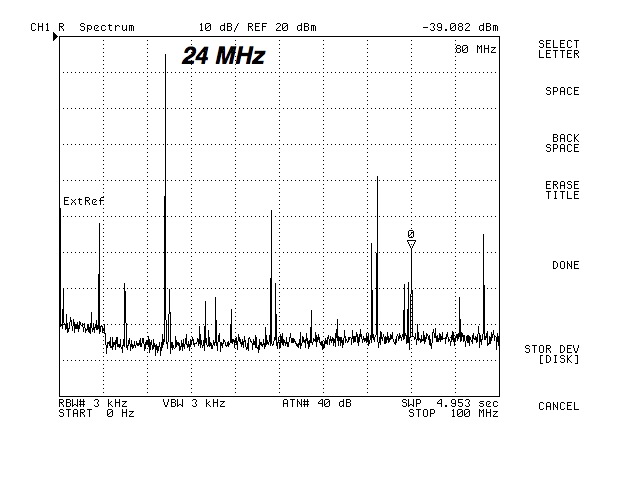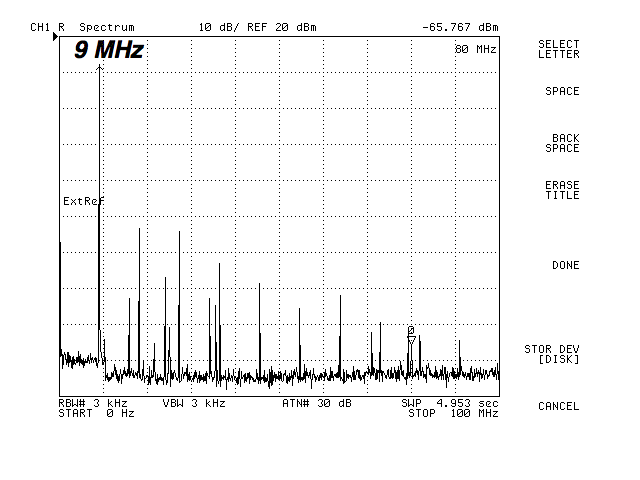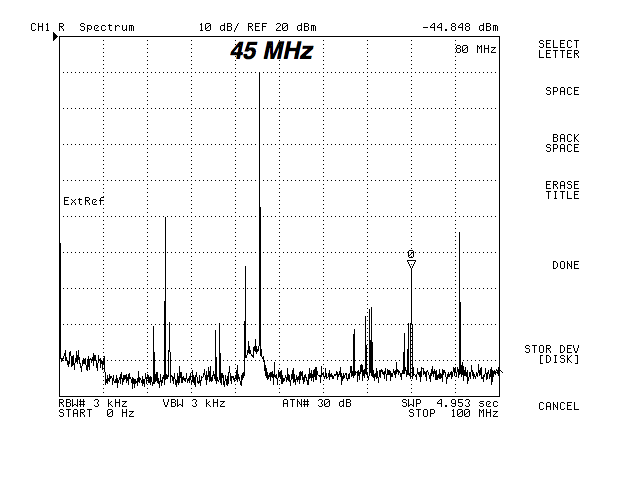Before starting messing up with IO alignments, Cheryl asked my to check if any major drift was visible in he HAM2 and 3 suspensions after the outage.
For the IMs, I restored the offsets that were in effect before the outage, and compared the OSEMs readings. No significant drift was observed. Results are summarized in the following table (the columns on the right are just a visual representation of the difference in log scale).
-------------------------------------------------------------------------------------------------------------
OSEMs readings comparison between gps = 1048629616 (reference) and gps = 1049482936
-------------------------------------------------------------------------------------------------------------
Channel name Value at T1 Value at T2 Differ. 1 10 100 1000
-------------------------------------------------------------------------------------------------------------
H1:SUS-IM1_M1_OSEMINF_UL_OUT_DQ +003.73+-5.18 +004.11+-1.16 +000.38 | | | |
H1:SUS-IM1_M1_OSEMINF_LL_OUT_DQ -082.58+-5.41 -080.89+-1.22 +001.70 |> | | |
H1:SUS-IM1_M1_OSEMINF_UR_OUT_DQ +017.31+-4.85 +018.25+-1.16 +000.94 | | | |
H1:SUS-IM1_M1_OSEMINF_LR_OUT_DQ -084.14+-5.18 -081.39+-1.28 +002.75 |>>> | | |
-------------------------------------------------------------------------------------------------------------
H1:SUS-IM2_M1_OSEMINF_UL_OUT_DQ -290.53+-2.85 -289.29+-1.90 +001.24 | | | |
H1:SUS-IM2_M1_OSEMINF_LL_OUT_DQ -242.12+-3.14 -236.62+-2.46 +005.50 |>>>>>> | | |
H1:SUS-IM2_M1_OSEMINF_UR_OUT_DQ +236.39+-3.13 +238.20+-3.44 +001.81 |>> | | |
H1:SUS-IM2_M1_OSEMINF_LR_OUT_DQ +132.75+-2.92 +138.67+-2.79 +005.92 |>>>>>>> | | |
-------------------------------------------------------------------------------------------------------------
H1:SUS-IM3_M1_OSEMINF_UL_OUT_DQ +171.96+-3.88 +170.05+-0.93 -001.90 |>> | | |
H1:SUS-IM3_M1_OSEMINF_LL_OUT_DQ -090.16+-3.86 -086.71+-0.90 +003.45 |>>>> | | |
H1:SUS-IM3_M1_OSEMINF_UR_OUT_DQ +141.78+-3.64 +139.41+-0.89 -002.37 |>>> | | |
H1:SUS-IM3_M1_OSEMINF_LR_OUT_DQ -138.79+-4.38 -135.01+-1.05 +003.77 |>>>>> | | |
-------------------------------------------------------------------------------------------------------------
H1:SUS-IM4_M1_OSEMINF_UL_OUT_DQ -075.93+-4.06 -063.20+-7.54 +012.74 |>>>>>>>>|> | |
H1:SUS-IM4_M1_OSEMINF_LL_OUT_DQ +283.91+-4.13 +295.35+-8.44 +011.44 |>>>>>>>>|> | |
H1:SUS-IM4_M1_OSEMINF_UR_OUT_DQ -210.78+-3.92 -199.14+-5.11 +011.64 |>>>>>>>>|> | |
H1:SUS-IM4_M1_OSEMINF_LR_OUT_DQ +123.32+-4.36 +134.96+-7.23 +011.64 |>>>>>>>>|> | |
I repeated the check for MC1, MC3 and PRM suspension. For technical reasons I had to keep the offsets off, so I compared the readings with a moment before the outage in which the watchdogs were tripped. Again, no major drift was observed.
-------------------------------------------------------------------------------------------------------------
OSEMs readings comparison between gps = 1048658416 (reference) and gps = 1049464816
-------------------------------------------------------------------------------------------------------------
Channel name Value at T1 Value at T2 Differ. 1 10 100 1000
-------------------------------------------------------------------------------------------------------------
H1:SUS-MC1_M1_OSEMINF_T1_OUT_DQ -034.70+-0.03 -034.09+-0.03 +000.61 | | | |
H1:SUS-MC1_M1_OSEMINF_T2_OUT_DQ -036.14+-0.05 -036.29+-0.03 -000.15 | | | |
H1:SUS-MC1_M1_OSEMINF_T3_OUT_DQ -003.59+-0.04 -003.57+-0.03 +000.02 | | | |
H1:SUS-MC1_M1_OSEMINF_SD_OUT_DQ +006.22+-0.20 +006.87+-0.05 +000.65 | | | |
H1:SUS-MC1_M1_OSEMINF_LF_OUT_DQ +010.79+-0.23 +010.52+-0.05 -000.27 | | | |
H1:SUS-MC1_M1_OSEMINF_RT_OUT_DQ +028.01+-0.23 +028.59+-0.05 +000.58 | | | |
H1:SUS-MC1_M2_OSEMINF_UL_OUT_DQ +012.16+-0.39 +011.65+-0.07 -000.51 | | | |
H1:SUS-MC1_M2_OSEMINF_LL_OUT_DQ +257.26+-0.39 +256.64+-0.06 -000.62 | | | |
H1:SUS-MC1_M2_OSEMINF_UR_OUT_DQ -134.76+-0.34 -135.18+-0.06 -000.42 | | | |
H1:SUS-MC1_M2_OSEMINF_LR_OUT_DQ +141.28+-0.60 +141.81+-0.08 +000.53 | | | |
H1:SUS-MC1_M3_OSEMINF_UL_OUT_DQ -046.67+-0.62 -047.22+-0.09 -000.55 | | | |
H1:SUS-MC1_M3_OSEMINF_LL_OUT_DQ +260.52+-0.57 +259.95+-0.07 -000.57 | | | |
H1:SUS-MC1_M3_OSEMINF_UR_OUT_DQ -067.45+-0.57 -067.82+-0.08 -000.37 | | | |
H1:SUS-MC1_M3_OSEMINF_LR_OUT_DQ +198.45+-0.65 +198.63+-0.08 +000.19 | | | |
-------------------------------------------------------------------------------------------------------------
H1:SUS-MC3_M1_OSEMINF_T1_OUT_DQ -008.19+-0.04 -008.33+-0.04 -000.14 | | | |
H1:SUS-MC3_M1_OSEMINF_T2_OUT_DQ -015.25+-0.07 -015.22+-0.03 +000.03 | | | |
H1:SUS-MC3_M1_OSEMINF_T3_OUT_DQ -020.96+-0.06 -021.16+-0.03 -000.19 | | | |
H1:SUS-MC3_M1_OSEMINF_SD_OUT_DQ -006.14+-0.07 -005.79+-0.05 +000.35 | | | |
H1:SUS-MC3_M1_OSEMINF_LF_OUT_DQ +008.46+-0.31 +008.51+-0.06 +000.05 | | | |
H1:SUS-MC3_M1_OSEMINF_RT_OUT_DQ -057.79+-0.33 -056.71+-0.06 +001.08 | | | |
H1:SUS-MC3_M2_OSEMINF_UL_OUT_DQ +143.88+-0.58 +144.30+-0.09 +000.42 | | | |
H1:SUS-MC3_M2_OSEMINF_LL_OUT_DQ +073.77+-0.91 +074.45+-0.11 +000.68 | | | |
H1:SUS-MC3_M2_OSEMINF_UR_OUT_DQ +079.45+-0.53 +080.13+-0.07 +000.68 | | | |
H1:SUS-MC3_M2_OSEMINF_LR_OUT_DQ +044.42+-0.73 +045.32+-0.08 +000.90 | | | |
H1:SUS-MC3_M3_OSEMINF_UL_OUT_DQ +092.77+-0.97 +093.25+-0.12 +000.48 | | | |
H1:SUS-MC3_M3_OSEMINF_LL_OUT_DQ +115.28+-1.26 +116.35+-0.16 +001.07 | | | |
H1:SUS-MC3_M3_OSEMINF_UR_OUT_DQ +082.64+-0.83 +083.89+-0.09 +001.25 | | | |
H1:SUS-MC3_M3_OSEMINF_LR_OUT_DQ +024.52+-1.46 +026.39+-0.16 +001.87 |>> | | |
-------------------------------------------------------------------------------------------------------------
H1:SUS-PRM_M1_OSEMINF_T1_OUT_DQ -010.93+-0.05 -011.00+-0.04 -000.07 | | | |
H1:SUS-PRM_M1_OSEMINF_T2_OUT_DQ +018.33+-0.06 +017.93+-0.04 -000.40 | | | |
H1:SUS-PRM_M1_OSEMINF_T3_OUT_DQ -011.63+-0.07 -011.87+-0.04 -000.24 | | | |
H1:SUS-PRM_M1_OSEMINF_SD_OUT_DQ -050.86+-0.21 -050.43+-0.06 +000.42 | | | |
H1:SUS-PRM_M1_OSEMINF_LF_OUT_DQ +001.20+-0.29 +001.34+-0.03 +000.14 | | | |
H1:SUS-PRM_M1_OSEMINF_RT_OUT_DQ -013.73+-0.29 -013.04+-0.03 +000.69 | | | |
H1:SUS-PRM_M2_OSEMINF_UL_OUT_DQ +064.17+-0.60 +064.34+-0.06 +000.17 | | | |
H1:SUS-PRM_M2_OSEMINF_LL_OUT_DQ +057.88+-0.88 +058.35+-0.07 +000.47 | | | |
H1:SUS-PRM_M2_OSEMINF_UR_OUT_DQ +021.27+-0.56 +021.52+-0.06 +000.25 | | | |
H1:SUS-PRM_M2_OSEMINF_LR_OUT_DQ +027.12+-0.81 +028.15+-0.06 +001.04 | | | |
H1:SUS-PRM_M3_OSEMINF_UL_OUT_DQ +023.28+-0.94 +024.00+-0.08 +000.72 | | | |
H1:SUS-PRM_M3_OSEMINF_LL_OUT_DQ -002.46+-1.23 -000.09+-0.09 +002.37 |>>> | | |
H1:SUS-PRM_M3_OSEMINF_UR_OUT_DQ +027.42+-0.91 +027.77+-0.07 +000.35 | | | |
H1:SUS-PRM_M3_OSEMINF_LR_OUT_DQ +066.64+-1.28 +068.56+-0.09 +001.92 |>> | | |
Finally, MC2 had to be compared with offsets off, but from a different period. Again, no major drifts or shifts in alignment.
-------------------------------------------------------------------------------------------------------------
OSEMs readings comparison between gps = 1048939216 (reference) and gps = 1049464816
-------------------------------------------------------------------------------------------------------------
Channel name Value at T1 Value at T2 Differ. 1 10 100 1000
-------------------------------------------------------------------------------------------------------------
H1:SUS-MC2_M1_OSEMINF_T1_OUT_DQ -032.01+-0.04 -028.31+-0.06 +003.70 |>>>>> | | |
H1:SUS-MC2_M1_OSEMINF_T2_OUT_DQ -076.77+-0.04 -074.11+-0.06 +002.66 |>>> | | |
H1:SUS-MC2_M1_OSEMINF_T3_OUT_DQ +007.41+-0.04 +010.39+-0.06 +002.98 |>>>> | | |
H1:SUS-MC2_M1_OSEMINF_SD_OUT_DQ -001.64+-0.06 -001.30+-0.12 +000.34 | | | |
H1:SUS-MC2_M1_OSEMINF_LF_OUT_DQ +025.48+-0.11 +024.70+-0.20 -000.78 | | | |
H1:SUS-MC2_M1_OSEMINF_RT_OUT_DQ +021.43+-0.08 +020.58+-0.14 -000.85 | | | |
H1:SUS-MC2_M2_OSEMINF_UL_OUT_DQ +027.67+-0.16 +026.48+-0.32 -001.20 | | | |
H1:SUS-MC2_M2_OSEMINF_LL_OUT_DQ +022.56+-0.22 +020.81+-0.45 -001.75 |> | | |
H1:SUS-MC2_M2_OSEMINF_UR_OUT_DQ +033.66+-0.17 +032.37+-0.32 -001.29 | | | |
H1:SUS-MC2_M2_OSEMINF_LR_OUT_DQ +052.13+-0.20 +050.76+-0.42 -001.37 | | | |
H1:SUS-MC2_M3_OSEMINF_UL_OUT_DQ +029.85+-0.25 +028.22+-0.54 -001.63 |> | | |
H1:SUS-MC2_M3_OSEMINF_LL_OUT_DQ -010.71+-0.29 -012.82+-0.61 -002.12 |>> | | |
H1:SUS-MC2_M3_OSEMINF_UR_OUT_DQ -020.21+-0.24 -021.43+-0.51 -001.22 | | | |
H1:SUS-MC2_M3_OSEMINF_LR_OUT_DQ +038.40+-0.34 +035.94+-0.73 -002.46 |>>> | | |






